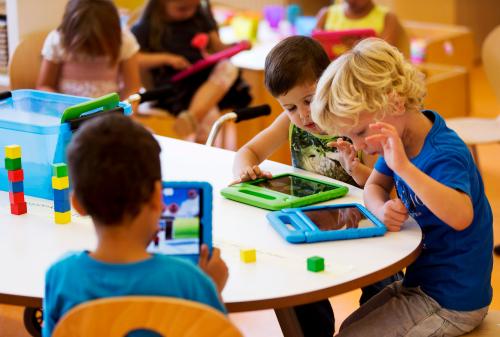This article is a summary of our new report on education innovations, which can be downloaded here.
By 2030, over half of the world’s young people are projected to reach adulthood without the skills they need to thrive in work and life. More worrisome still, we estimate that it will take decades—in some places over 100 years—for children of poor families to catch up to the learning levels of the richest. Faced with this urgent learning crisis, can we chart a new path forward to achieve rapid, equitable educational progress across the globe?
In our new report, Can We Leapfrog? The Potential of Education Innovations to Rapidly Accelerate Progress, we examine the possibility of leapfrogging—rapidly accelerating educational progress to ensure that all young people develop the skills they need to thrive in a fast-changing world. We argue that, globally, education faces two major problems: skills inequality and skills uncertainty. The former concerns the massive and enduring inequalities in educational opportunity that affect children and youth in many countries in the world. And the latter refers the fact that, in the context of rapid and far-reaching social and economic change, we must prepare youth with a broad suite of skills—including, but going beyond, traditional academic competencies. Together, these twin problems compel us to strengthen existing learning models for all children while simultaneously reorienting education to prepare them for the future.
As such, we define leapfrogging—a concept rarely used in the education space—as any practices that tackle one or both of the twin problems. Though effectively addressing skills inequality alone is certainly a meaningful leap in many contexts, we argue that the global community must set its sights on helping all children develop a breadth of skills, regardless of their schooling history or means. In other words, we hold that a leapfrogging should seek to address both skills inequality and skills uncertainty at the same time.
This report makes two major contributions to the global effort to ensure that children and youth are prepared to thrive. First, we map the state of the innovations community by studying a catalog of nearly 3,000 global education innovations—the largest such collection to date. Second, we present an evidence-based, theoretical pathway for leapfrogging education. We analyze cataloged innovations against this pathway to gauge the potential of innovations to enable leapfrogging today.
Our study highlights a diverse, energetic community of education innovators working to transform learning in nearly every imaginable context. Indeed, more than 85 percent of the world’s countries host innovations included in our catalog, and nearly two-thirds of innovations target marginalized youth populations.
The vast majority of innovations make use of the playful learning experiences necessary for developing a breadth of student skills, and nearly half of cataloged innovations use technology to accomplish their goals. For example, schools in Brazil are encouraging youth to learn academic content by designing apps and other digital products, and learners in rural India are telling stories and playing academic games with free offline tablets. Moreover, nearly 40 percent of innovations have found new ways to unburden teachers and unleash their creativity—from streaming practicing biologists into a science classroom to implementing adaptive learning games that track student achievement.
However, noticeable gaps exist that will impede leapfrogging. Despite the focus on unburdening teachers, less than one-quarter of innovations work to develop teachers’ skills and capacities. Innovations similarly overlook novel means of recognizing student learning—that is, changing how learners demonstrate competencies and progress through schooling. We note, too, that innovations are not tapping the full potential of technology. The above examples are the exception, as less than 20 percent of tech-enabled innovations use technology in a way that transforms the teaching and learning process.
Ultimately, we are optimistic about the potential of innovations to leapfrog education for all learners. Children from poor and wealthy families alike are participating in new approaches that are changing, with impressive results, how schooling is delivered, what is taught, and how teachers teach. If the education innovations community can tackle the current gaps—and make a concerted effort to collect and share the effectiveness data necessary to bring promising interventions to scale—we can set global education on a leapfrog path that will ensure all learners are prepared to succeed in a fast-changing world.






Commentary
Can education innovations help us leapfrog progress?
September 21, 2017